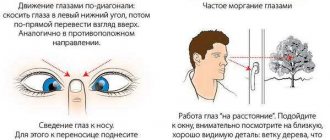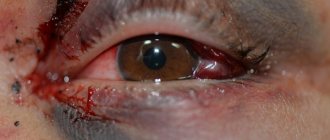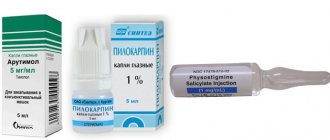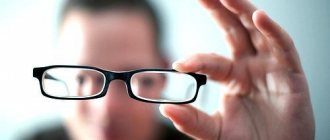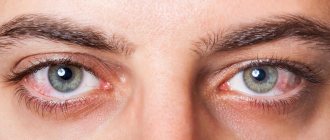If you have problems clearly seeing objects in the distance, cannot distinguish letters when reading at the usual distance, or get very tired when working in an office, then you need to check your visual acuity and choose glasses or replace the ones you use.
- Where to check
- How to prepare
- Visual acuity test
- Refractive Study
- Other methods of studying refraction
- Binocular vision study
- Glasses prescription
Where to check
To select glasses, you need to test your visual acuity and get a prescription for glasses. Today, visual acuity testing can be done: in the office of an optometrist in an optical salon, at an appointment with an ophthalmologist in a clinic, and using tests on the Internet, online. Online vision testing is gaining popularity - there are many sites dedicated to vision where you will be asked to download various tests onto your computer to test your vision at home. For example, you can download and print a table with Landolt rings, hang it on the wall and try to read the letters from a certain distance. Or set the size of the letters that are most clearly visible on the screen for each eye. These classes can be quite interesting, but will not help you understand what glasses you need. At home, using a homemade table or using a computer, it is possible to determine visual acuity only very approximately, since it is impossible to comply with all the conditions for conducting such tests: lighting level, contrast and size of characters, distance, etc. In addition, such studies of visual acuity are not allow you to find out which optical power lenses, spectacle or contact, will provide the clearest and most comfortable vision. Only a specialist can determine which lenses are needed by examining your refraction using a set of trial spectacle lenses.
An ophthalmologist at the clinic will determine visual acuity, but even if you have a prescription, it is worth double-checking this data in an optical salon. Eyeglass correction professionals often have to deal with customer complaints about the quality of vision in new glasses that match a prescription issued by another institution. In this case, the customer does not have the right to make any claims to the glasses manufacturers. Checking or rechecking visual acuity in an optometrist’s office will be the key to producing high-quality glasses, and companies often carry it out free of charge when you subsequently place an order with them. Currently, many optical salons have an office of an optometrist or ophthalmologist, equipped with modern diagnostic equipment. A list of stores with a doctor's office in your area.
Why can't you test your eyesight in 10 minutes?
The main stages, let's look at everything in detail.
1. Anamnesis collection. It takes on average 10 minutes, but you can’t do without it! At the first stage of the check, it is important for the specialist to find out information about the patient: 1. Reason for contacting the optician? 1. Have you had any injuries or surgeries on your eyes? 3. Are there any chronic diseases? 4. What lenses or glasses do you use or have you used? Answering these simple questions will help you make the correct diagnosis and avoid complications in the future.
2. stage. Checking the client's glasses. If you wear glasses, always come to the optician wearing them or bring them with you. It is important for a specialist to know what correction is in your glasses. This can be seen on a special device - a dioptrimeter. The device shows data such as what “-“ or “+” lenses are in your glasses, whether there is astigmatism, the set interpupillary distance, and even the design of the glasses lenses (progressive or single vision). All this information is important for correct and more accurate correction, or to eliminate shortcomings, if, suddenly, these glasses are uncomfortable for you, so do not forget them at home, they, like an encrypted code, carry important data.
3. stage. Testing the buyer's vision without correction. To do this, the specialist uses the Golovin-Sivtsev table or, simply put, “ShB” on a sign projector. The table consists of 12 rows of letters or signs of a certain size. The client sits opposite her at a certain distance. Visual acuity is always checked monocularly, i.e. each eye in turn. The test always begins with the right eye. During the test, both eyes are always open and the client covers each eye in turn with a special spatula. It is forbidden to squint at this moment. Using a correctly named series of letters without errors, the specialist assesses the buyer’s visual acuity. 4.stage. Autorefractometry. You can use a word instead of a tongue twister. So, this device was seen by everyone who was in the ophthalmologist’s office in our salons, and everyone who had an eye test necessarily went through it! This high-tech device should be in every optician; it shows the metric parameters of the human eye: the basic curvature of the cornea, for example... It can also be used to obtain preliminary data on refractive error (vision), the total interpupillary distance and the presence of astigmatism (don’t be afraid of this word, it means just a feature of the structure of the eye, we’ll talk about it in a separate post) The whole procedure on the device takes no more than 5 minutes: the doctor takes a picture on an autorefractometer, prints out the data obtained and moves on to the next stage... but that’s a completely different story.
5.stage. Slit lamp examination (biomicroscopy). In simple terms, this device is like a large microscope with a lamp that repeatedly magnifies the structure of the eye so that the doctor can determine whether you have any pathologies of the cornea. What can be detected with a slit lamp: inflammation, foreign bodies, microtraumas, various disorders. The procedure itself takes no more than 10 minutes, but not a single ophthalmologist appointment in our salons is complete without it.
6.stage. Vision tests - measurement using a pupillometer. This device with a mysterious name measures interpupillary distance. Not a single order of glasses can be done without these readings, for example, to measure the distance for glasses for distance, an infinity sign is set on the device, this means that the person’s gaze is directed into the distance, and to measure the interpupillary distance for glasses for near, the required value is set on the device, at which a person works or reads, for example, 40 cm. Did you know that in most cases the interpupillary distance for the right and left eyes is different? The interpupillary distance is measured in millimeters from the bridge of the nose to the center of the right pupil and from the bridge of the nose to the center of the left pupil. To measure, the device is placed on the bridge of the client’s nose, held on both sides with hands, and the doctor takes the measurement. We remind you that in our salons it is possible to select glasses by appointment by calling 8-922-947-29-97.
7.stage. Measuring parameters on a phoropter. In essence, the device replaces a specialist’s diagnostic kit, consisting of a frame and lenses. Using this set, the doctor manually changes the lenses in the frame one by one, thereby selecting the necessary correction. The phoropter automates this work; moreover, the device itself has a number of advantages: - reduces the likelihood of error on the part of the doctor, - increases the speed of selecting a correction for the patient, - is convenient and easy to use. This is such a useful and smart thing. Available in every doctor's office in our salons.
8. stage. The stage at which the doctor puts a trial frame on the patient. This is a test version of the buyer's future glasses. In modern optics, trial frames are a popular and effective method for selecting high-quality glasses. The patient can personally verify that the selected lenses are comfortable for the eyes by spending some time wearing the frame at the optician. And only after this, after making sure that the client is comfortable, the doctor writes out the final prescription.
10. stage. Choice of frames.
ROUND or BLACK? We're talking about frames. So, the client has a prescription for glasses in his hands. And we move from the doctor’s office to the sales floor to carry out the 8th stage - choosing a frame. Usually, when choosing a frame, clients are divided into two camps: those who enjoy this process and those for whom it is a lot of stress. We understand that it is very difficult to navigate a large assortment, so optician consultants will always come to the rescue. They will suggest the correct form, taking into account your wishes and taking into account your prescription for glasses. There are even cases when the model you like, unfortunately, does not suit the recipe, but you can always find a good alternative.
Check your vision once every six months and look at the world clearly and clearly!
Phone number to make an appointment with a doctor: 8-922-947-11-47.
How to prepare
No special preparation is required for the vision test. You just need to provide the specialist with complete information about your vision problems. Remember at what time they arise: first thing in the morning or after long work, in what situations you experience discomfort and what it is. Think about what types of activities you need glasses for: reading, working on a computer, etc. If you already use glasses or contact lenses, take them with you so that the specialist can take their parameters into account when selecting new ones. You must also bring your previous prescription for glasses.
Before the visual acuity test begins, your eye doctor or optometrist will talk with you and ask questions to learn about you, your eyes, and your overall health. Be prepared to talk about common diseases, hereditary eye diseases, special risk factors for professional activities, medications taken, and allergies. Remember that some medications can affect your vision, causing short-term or long-term side effects. Thus, non-steroidal anti-inflammatory drugs, antiarrhythmic drugs, antidepressants, neuroleptic drugs, calcium channel blockers, oral contraceptives, tranquilizers, psoriasis drugs, tetracycline, thiazide diuretics and some others help increase the photosensitivity of the organ of vision. A number of drugs sometimes cause changes in pupil size by affecting the light sensitivity of the eye - atropine and other anticholinergics, scopolamine, antibiotics (fluoroquinols and tetracyclines), anticonvulsants (phenytoin), antidepressants (selective serotonin reuptake inhibitors), antihistamines, central nervous system stimulants (amphetamines, cocaine), sedatives (benzodiazepines), drugs to prevent erectile dysfunction, phenothiazines.
Visual acuity test
Visual acuity is the ability of the eye to distinguish small details of an object from a certain distance. It changes depending on the light. Visual acuity can be different for each eye due to hereditary characteristics or acquired defects (myopia, farsightedness, astigmatism, cataracts and other deviations of the visual organ from the norm). In addition, visual acuity decreases with age. Testing visual acuity includes examining the ability of the eyes to distinguish details near and at great distances, the ability to distinguish colors, and studying the field of vision (determining its defects). Many optometrist offices in optical salons are equipped with autorefkeratometers, which allow you to quickly determine objective refraction, which helps in selecting the necessary correction tools. However, these measurements cannot replace a prescription for glasses (See the article prescription for glasses).
When checking distance visual acuity, special tables are used, which are viewed from a certain distance under standardized lighting. For adults, Golovin-Sivtsev tables with letter optotypes and Landolt rings are intended. To determine visual acuity in children, they use E. M. Orlova’s table, on which images of objects and animals serve as optotypes.
The tables consist of 12 rows of randomly arranged letters or signs of a certain size - optotypes. In each row the optotypes are the same size, but from the top row to the bottom they gradually become smaller. The size of optotypes changes in arithmetic regression: in the first ten rows, neighboring ones differ by 0.1 units of visual acuity, in the last two rows - by 0.5. When using the Golovin-Sivtsev table, visual acuity is determined from five meters. If the patient from this distance sees the details of the optotypes of the 10th row of the table, then his visual acuity is 1.0. At the end of each row of optotypes, under the symbol V, the visual acuity of the patient who read this row from five meters is indicated. Distance visual acuity can also be tested using special devices - sign projectors. In this case, a set of letters or symbols of different sizes is projected onto a screen hanging on the wall. The patient is required to name the letters shown or identify the symbols.
Rules for testing visual acuity: 1. Visual acuity should be examined monocularly - separately for each eye. And always start from the right. 2. Both eyes of the patient should be open, one should be covered with a shield made of opaque material. In the absence of a shield, you can cover the eye with the palm (but not the fingers) of the patient. It is important not to press through the eyelids on the closed eye, as this may cause a temporary decrease in visual acuity. The shield or palm should be held vertically in front of the eye so that the possibility of intentional or unintentional peeking is excluded, and the light enters the open palpebral fissure from the side. It is unacceptable to squint when examining visual acuity; in case of myopia, this leads to increased visual acuity;
3. The study should be carried out with the head and eyelids in the correct position. You need to make sure that your head is not tilted to either shoulder, forward or backward, and not turned to the right or left. 4. It is necessary to take into account the time factor: during a routine check, the time for determining the optotype is 2–3 s, during control expert studies – 4–5 s; 5. Optopips should be shown in the table with a pointer, the end of which should be clearly visible; when working with a sign projector - a laser pointer; 6. You need to start checking by showing the breakdown of optotypes in the 10th row of the table and gradually move on to rows with larger characters. In children and patients with reduced visual acuity, it is permissible to start checking from the top, showing one sign at a time to the row where the patient made a mistake, and then return to the previous row. Visual acuity must be assessed using a series in which all signs were correctly named. One error is allowed in rows 3–6 and two errors in rows 7–10; errors are recorded in the test result record. To test near vision, use a small card with several paragraphs of text printed on it. Each paragraph is written in letters of different sizes. The card is held at a distance of 33–35 cm. A patient with normal near vision should read a paragraph whose letter size corresponds to a visual acuity of 1.0. If, as a result of the test, it is determined that visual acuity is below normal (visual acuity equal to 1.0 is taken as normal), then the ophthalmologist will then examine the reasons for this decrease and determine the patient’s refraction.
Magazine
It is recommended to check your vision as a preventive measure at least once a year in order to notice its deterioration in time. And if you have problems with your eyes, you need to make an appointment with a doctor immediately in order to have time to solve them at the initial stage.
Olga Nikolaevna Shlykova , an ophthalmologist of the highest category, a specialist at Point of View, explains what three types of vision tests exist and how they differ from each other.
Express diagnostics are carried out free of charge in Point of View optical salons.
This type of diagnosis gives a general idea of the state of vision. Sometimes that's enough. For example, when a patient wears glasses and just wants to make sure that they fit him.
Express diagnostics includes the following procedures:
- refractometry - using a special apparatus, the doctor obtains data on the refractive power of a person’s eyes, and then refines them manually using lenses of different diopters;
- visometry - using the Sivtsev table, the doctor looks at how well a person sees into the distance.
“As a rule, we compare data over time. If a patient previously saw 10 lines of letters with glasses with diopters -3, but now only seven, then a full optometric examination needs to be carried out,” explains Olga Nikolaevna Shlykova.
Full optometric examination Cost: 590 rubles*, free when purchasing glasses.
The main task and result of an optometric examination is the selection of vision correction products. It includes:
- full vision test - refractometry, visometry, whether stereo vision is impaired, how the accommodative and refractive apparatus of the eye work;
- selection of lenses with appropriate tests;
- final choice of points.
“An optometric examination does not always provide a comprehensive picture of the condition of the visual organs. If I see that a patient has high degrees of myopia, I will recommend that he undergo a fundus examination. It will show the condition of the optic nerve head and retinal vessels. And this needs to be done at least once a year. But this type of examination is already included in a full ophthalmological examination,” says Olga Nikolaevna Shlykova, specialist at Point of View Optics.
Full ophthalmological examination Cost: 820 rubles*, free when purchasing glasses.
An ophthalmological examination is:
- full optometric examination;
- indirect ophthalmoscopy - examination of the fundus;
- biomicroscopy - examination of the eye using a slit lamp;
- tonometry - measurement of intraocular pressure;
- recommendations for eye care with a prescription.
This type of test allows you to identify a variety of vision pathologies, and not just those that are associated with a minus or a plus, that is, myopia or farsightedness.
“In fact, in the Point of View optical salons there is a standard ophthalmologist’s office with all the equipment necessary for testing vision. All this allows us to correctly diagnose and prescribe treatment. When a full ophthalmological examination is not enough, we give the patient referrals for additional, highly specialized studies,” says Olga Nikolaevna Shlykova.
So, when examining the fundus, you can only notice an incipient brain tumor. In this case, the doctor will advise the patient to additionally consult a doctor of another specialization. “By examining the eyes, we can draw conclusions about the condition of a completely different organ or the entire organism as a whole. Clients are very grateful that we noticed a serious problem in time,” explains the Point of View optics specialist.
You can make an appointment with an ophthalmologist here.
*Prices are for vision tests in adults and are valid for 2018.
Refractive Study
Determining refraction using a set of trial lenses is the oldest method. It allows you to set the optical power of the lens, which, when placed in front of the eye, provides the highest visual acuity. The study consists of testing the quality of vision with diagnostic lenses of different optical powers. To do this, the patient usually puts on a special trial frame, into which different lenses are inserted one by one, depending on whether the refraction is positive or negative according to the autorefractometer.
If autorefractometry has not been carried out, then, by attaching weak plus and minus lenses, they find out in which case the vision has improved, and then select lenses of the appropriate sign. lenses Successively try lenses of increasing optical power until the maximum visual acuity for the eye is achieved. For myopia, a lens with minimal refractive power is prescribed, providing high visual acuity. With farsightedness, on the contrary, with maximum refractive power, at which visual acuity is the highest. Then a visual acuity test is performed binocularly, that is, both eyes together. In this case, the visual acuity of each eye should be 0.9–1.0. And if the quality of vision is different, then the maximum permissible difference in the optical power of the prescribed lenses should be no more than 2-3 diopters, depending on the patient’s individual tolerance. Identifying the type and degree of astigmatism involves determining the spherical and astigmatic components of the correction, as well as the position of the axis of the astigmatic lens, which ensures maximum visual acuity. To determine astigmatism, so-called astigmatic figures are often used, and when using optotypes, crossed cylinders are used.
The research method is based on the uneven vision of lines of different orientations in astigmatic figures, or, as they are sometimes called, dials, with an astigmatic eye. These figures are used both to identify astigmatism and to determine its degree and the position of the main sections. Crossed cylinders are used mainly at the final stage of refraction research to clarify the degree of astigmatism and the position of its main sections, that is, the strength and direction of the axis of the correcting cylinder. After installing the lenses in the trial frame, the patient should be allowed to stay in the trial frame for several minutes, read, and walk around to check the tolerance of the corrective lenses. The parameters of these lenses are indicated in the prescription for glasses or contact lenses. The interpupillary distance is measured after selecting the correction using a set of trial lenses or a phoropter. Typically, the distance between the centers of the pupils is measured using a regular ruler or a special device - a pupilometer. In well-equipped ophthalmological offices, special electronic measuring systems are used that allow all the necessary lens centering parameters to be established with high accuracy. Incorrectly measured interpupillary distance will result in incorrect alignment of the lenses in the frame, which, in turn, can cause poor health under visual strain. The prescription indicates the interpupillary distance for both eyes, and if it is necessary to prescribe progressive or aspheric lenses, the monocular pupillary distance.
A visual field test is performed to test peripheral vision. The field of view is the area that is visible from a certain direction of view. Objects in the center of the visual field are visible more clearly than those located in the periphery. Color vision tests are used to test the ability to distinguish colors. This test allows us to identify color blindness (color blindness) in patients with suspected retinal or optic nerve disease or with a hereditary predisposition to color blindness, that is, who have a family history of color blindness.
How often should your visual acuity be checked?Visual acuity should be checked regularly. If there are no vision problems, then, according to the general recommendations of various specialists, with the following frequency:
If visual impairment is detected, the ophthalmologist may order more frequent checks. |
Points selection rules
- Contact only professional opticians and vision correction clinics.
- Be careful and honest with your doctor during the process of selecting spectacle lenses - the safety of use and comfort while wearing glasses depends on this
- Make sure you follow the correct and precise algorithm of actions when selecting glasses, which consists of the following steps:
Visual acuity test
The main thing in glasses is the lenses. To select them correctly, the patient undergoes a full examination by an ophthalmologist.
- You can check your visual acuity using a special device - an autorefractometer. But his performance is not enough to order glasses.
- The Sivtsev table or an automatic distance sign projector helps to obtain the necessary information about the patient’s vision and select the appropriate lens power. At this stage, each eye is checked separately: first the right, then the left. If the patient correctly reads the last line in the table, his vision is 100% and, as a rule, glasses correction is not required.
After checking visual acuity without correction and identifying problems, a trial frame with “plus” (collective) or “minus” (divergent) lenses is brought or automatically moved to the patient’s eye. Glass with different optical powers is changed until the highest visual acuity is achieved.
The lens is selected as the refractive power increases: visual acuity of each eye is corrected to 1.0-0.9 or less (depending on tolerance and the degree of refraction of the patient). When the lenses are selected correctly, visual acuity in both eyes varies from 0.9 to 1.0 and comfortable binocular vision is noted.
In order to determine truly suitable and comfortable glasses, stay in a trial frame with lenses for several minutes: read, walk around, look at something at different distances.
Measuring the distance between the pupils
For complete vision correction, it is important to choose the correct fit of glasses. To do this, ophthalmologists measure the patient's interpupillary distance. In other words, doctors center the lenses in glasses. This procedure is carried out using a regular ruler, determined using data from an autorefractometer, or using a special device - a pupillometer. Typically, the interpupillary distance in reading glasses is 2 mm less than in distance glasses. Incorrect alignment of glasses causes discomfort, decreased vision and headaches.
Glasses prescription
The result and result of all research and examinations, selection of lenses and frames is a prescription for the purchase of glasses. An ophthalmologist or optometrist can write a prescription for glasses. The correct prescription for glasses contains the following items:
- Complete patient data
- Lens power
- Interpupillary distance
- Purpose of glasses (for reading, working at a computer, constant wearing).
Keep your prescription for glasses written by your doctor: if your vision worsens or improves with the help of a prescription, your ophthalmologist will monitor the dynamics of changes and determine further tactics.
The selection of glasses in our clinic is carried out using new technologies and after examination using the most modern equipment. With us, you can get a prescription for glasses that are right for you in comfortable conditions and with full confidence in your doctor.
Other methods of studying refraction
The duochrome test is based on the phenomenon of chromatic aberration in the eye. It consists in the fact that short-wave rays (blue-green) are refracted more strongly than long-wave rays (red), and therefore the focus of blue-green rays is located closer to the cornea than the focus of red ones. Thus, the myopic eye sees more clearly in red light, and the hyperopic eye sees more clearly in green light.
The subject is shown a luminous display, the left half of which is colored green, and the right half is colored red. Both have symmetrical black optotypes. The subject with a selected lens is asked to indicate against which background the signs seem clearer or blacker to him: red or green. If it is red, then the eye alignment is myopic and a negative lens of greater optical power should be installed in front of the eye, and a positive lens of lower optical power; if it is on a green background, then the eye setting is hypermetropic and you need to choose a weaker negative lens, and a stronger positive lens, on the contrary.
Binocular vision study
The test with covering the eye (cover test) makes it possible to detect obvious or hidden strabismus with a high probability. The patient sits opposite the specialist and looks intently, without blinking, at some distant object located behind him. In this case, the specialist covers either the patient’s right or left eye without intervals. If at the moment of opening (transferring the shutter to the other eye) neither eye makes movements, then, most likely, there is no strabismus; if movement is noted, then strabismus occurs: divergent - when moving towards the nose, or converging - in the direction of the ear. In the case of obvious strabismus, when opening one eye (the leading one), both make a quick adjustment movement in one direction, and when opening the other eye (the squinting one), they remain motionless. Latent strabismus is characterized by slow movement of only the eye that opens.
Glasses prescription
After determining visual acuity, the ophthalmologist or optometrist writes a prescription for the manufacture of glasses, which indicates: the patient’s data, the functional purpose of the glasses (for distance, for reading, for constant wearing, etc.), the required optical power of spherical and, if necessary, cylindrical lenses (indicating the values of the cylinder axes), interpupillary distance.
All prescriptions written out should be saved, since if necessary, they can be used to determine how vision has changed over time.
The selection of glasses should be carried out by a qualified specialist. Incorrectly chosen glasses can cause constant eye fatigue, cause headaches, fatigue, and impaired performance. Prepared by Olga Shcherbakova List of stores with a doctor's office in your region Other articles on the topic:
Visual defects and methods for their correction
Selection of contact lenses
How often should you have vision tests?
Those who already have reduced vision, and especially contact lens users, need to undergo an eye test and visit an ophthalmologist at least once a year. For certain indications, more frequent visits may be scheduled.
Those who have excellent vision can be tested once every 2 years.
However, it is worth remembering that if any unpleasant symptoms appear, if you feel that your vision has become cloudy, there is increased eye fatigue, headaches, redness, itching and irritation, you must visit an ophthalmologist as soon as possible and undergo an examination. This recommendation also applies to those who have not had vision problems, glasses users, and even more so contact lens users.
Why should contact lens users have their eyes checked regularly?
Regular vision tests for contact lens wearers assess overall eye health. This is important because the patient inserts a foreign object into the eye every day, which in itself is a risk factor for complications. But with strict adherence to hygiene rules, complications almost never occur when using contact lenses. However, most people tend to violate the rules of lens care: they wear them for too long without removing them, use them beyond the required replacement period, fall asleep in the lenses and carry out the cleaning procedure incorrectly. All this can lead to allergies or infections, so all contact lens users are advised to regularly check their vision. Some eye health conditions may contraindicate contact lenses and may require immediate treatment.
Regular eye examinations also help ensure that the contact correction used is still appropriate. After all, vision can deteriorate even when using contact lenses. If the optical power of the lenses is insufficient, the patient can strain his eyes too much to see objects, this causes overstrain of the eye muscles, their spasms and even greater deterioration of vision. Therefore, all contact lens users should have their vision checked periodically to ensure that the correction they are using is still appropriate for them.
Why have your eyes checked before purchasing your first contact lenses?
Choosing and purchasing your first contact lenses is a crucial moment, because incorrectly selected contact lenses can not only significantly reduce visual acuity, but also greatly undermine the overall health of the eyes. The fact is that, firstly, wearing contact lenses is not recommended for everyone. There are conditions of the eyes and conjunctiva when the use of contact lenses is strictly contraindicated. The ophthalmologist should always make sure that contact correction is possible in your particular case. There is no way to check this on your own.
Secondly, contact lenses have a number of parameters: optical power, diameter, radius of curvature. You cannot buy your first lenses without a thorough examination and selection of contact lenses. Contact lenses that do not match your visual acuity and that do not fit correctly on your eyes can significantly reduce your visual acuity and lead to new problems. Therefore, be sure to consult an ophthalmologist before purchasing your first contact lenses. He will conduct an examination, assess the condition of your vision, and you will try on several pairs of contact lenses right in the office and, together with your doctor, choose the most suitable and comfortable ones. The ophthalmologist will write a prescription for contact lenses, which will indicate all the parameters of the lenses. It is in accordance with the parameters specified in the prescription that you will subsequently buy contact lenses.
